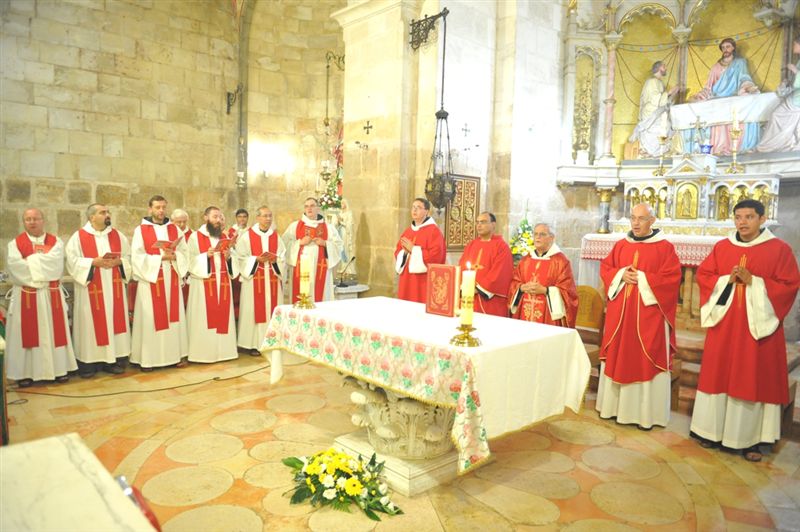
Emmaus, September 30, 2012
On Sunday, September 30th, two buses full of friars, religious and laity traveled to Emmaus-Qubeibeh to commemorate the Feast of Sts. Simeon and Cleophas. The friars of the Community living there welcomed them: Fra Fadi Shallufi, Fra Gérard Bourdonneau and Fra Francisco Fernandez Gutierrez.
The Shrine at Emmaus commemorates the manifestation of the Risen Lord to the disciples, Cleophas and Simeon, who were also martyrs. While commemorating an event of the past, the liturgy of the Holy Land is never separated from the “here and now”.
The Mass was celebrated by the Vicar of the Custody, Fra Artemio Vítores in the Basilica built upon the ruins, which tradition recognizes as the house of Cleophas.
In his homily, Fra Artemio urged those present, “Today Jesus asks us the same question as he did the disciples of Emmaus; do we believe that Jesus is the center of our lives and the ‘way’ to arrive at the glory of the Resurrection?”
Cleophas and Simeon are the two disciples who, after the resurrection, return to Emmaus and are joined along the way by the Risen One, whom they recognize only after they arrive home and offer him hospitality.
“We had hoped that he would be the one who would deliver Israel, but…” In the words of the two disciples, turning to the unknown, there is the echo of a disappointment common to the apostles in time of trial. “Some women from our group, however, have astounded us.” From this glimmer of hope, the light of the “good news” penetrates the unknown, explaining to them the Scriptures and then accepting their invitation: “Stay with us, for it is nearly evening and the day is almost over.” Christ is revealed to them in “the breaking of the bread,” the Eucharistic gesture of the Last Supper.
The tradition is carried through to the present time as the Franciscans identify the Emmaus Gospel with the village of Qubeibeh, now a Muslim village, save one Christian family. The village is located in the West Bank, not far from Jerusalem, and separated by the security wall. It remains in the care of the friars, and, with special permit, is open for pilgrims who wish to visit this Holy Place.
A fraternal gathering was shared in the refectory before returning to Jerusalem.
On Sunday, September 30th, two buses full of friars, religious and laity traveled to Emmaus-Qubeibeh to commemorate the Feast of Sts. Simeon and Cleophas. The friars of the Community living there welcomed them: Fra Fadi Shallufi, Fra Gérard Bourdonneau and Fra Francisco Fernandez Gutierrez.
The Shrine at Emmaus commemorates the manifestation of the Risen Lord to the disciples, Cleophas and Simeon, who were also martyrs. While commemorating an event of the past, the liturgy of the Holy Land is never separated from the “here and now”.
The Mass was celebrated by the Vicar of the Custody, Fra Artemio Vítores in the Basilica built upon the ruins, which tradition recognizes as the house of Cleophas.
In his homily, Fra Artemio urged those present, “Today Jesus asks us the same question as he did the disciples of Emmaus; do we believe that Jesus is the center of our lives and the ‘way’ to arrive at the glory of the Resurrection?”
Cleophas and Simeon are the two disciples who, after the resurrection, return to Emmaus and are joined along the way by the Risen One, whom they recognize only after they arrive home and offer him hospitality.
“We had hoped that he would be the one who would deliver Israel, but…” In the words of the two disciples, turning to the unknown, there is the echo of a disappointment common to the apostles in time of trial. “Some women from our group, however, have astounded us.” From this glimmer of hope, the light of the “good news” penetrates the unknown, explaining to them the Scriptures and then accepting their invitation: “Stay with us, for it is nearly evening and the day is almost over.” Christ is revealed to them in “the breaking of the bread,” the Eucharistic gesture of the Last Supper.
The tradition is carried through to the present time as the Franciscans identify the Emmaus Gospel with the village of Qubeibeh, now a Muslim village, save one Christian family. The village is located in the West Bank, not far from Jerusalem, and separated by the security wall. It remains in the care of the friars, and, with special permit, is open for pilgrims who wish to visit this Holy Place.
A fraternal gathering was shared in the refectory before returning to Jerusalem.

